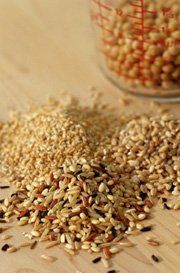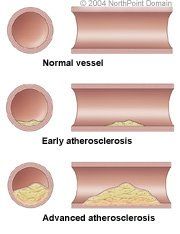Eating to Lower Cholesterol
Basic Facts
- Cholesterol is a fatty, waxy substance. Too much cholesterol in the blood can speed up hardening of the arteries, which increases the risk for stroke, heart attack, and other types of vascular disease.
- Heart and vascular diseases are the major killers of Americans.
- Controlling high cholesterol lowers the risk of developing vascular disease.
- Eating a diet that is low in saturated fat and cholesterol and high in fiber can reduce high cholesterol.

Too much cholesterol in the blood can speed up hardening of the arteries. In healthy people, high cholesterol is at or above 200 milligrams per deciliter (mg/dL).
It's important to treat high cholesterol as soon as a physician diagnoses it. High cholesterol, especially high LDL ("bad") cholesterol, increases the risk for heart and vascular disease.
When LDL levels are high enough to increase the risk for coronary heart disease or vascular disease, physicians usually recommend people first change their diet and add other lifestyle changes such as exercising.
Eating plans that lower cholesterol:
- Reduce saturated fat to 7 percent of daily calories;
- Include 25 to 35 percent or less of daily calories from total fat; and
- Limit dietary cholesterol to 200 mg a day.
WHAT CONDITIONS WILL IT HELP?
A diet that lowers cholesterol will help reduce the risk for:
- Heart attack;
- Stroke;
- Angina pectoris;
- Peripheral arterial disease;
- Carotid artery disease;
- Diabetic vascular disease;
- Renal failure and renovascular conditions; and
- Aortoiliac occlusive disease.
GETTING STARTED
The physician will test the patient's blood cholesterol levels and ask the patient about his or her health history and lifestyle.
Additionally, the physician will:
- Determine whether the patient has existing heart or vascular disease;
- Determine the patient's other risk factors, such as diabetes, hypertension, a family history, and smoking; and
- Calculate a patient's risk of having an event such as a heart attack.

WHO IS ELIGIBLE?
All patients are eligible for a diet that lowers cholesterol.
Diet and other lifestyle changes may be all some patients need to reach their optimal cholesterol levels. Even patients who take cholesterol-lowering medications can benefit from diet changes.
WHAT TO EXPECT
Following are the components of a cholesterol-lowering diet:
- Grains, at least 6 servings a day;
- Vegetables, 3 to 5 servings a day;
- Fruits, 2 to 4 servings a day;
- Low- or non-fat dairy products, 2 to 3 servings a day;
- Eggs, less than 2 yolks per week;
- Lean meats, poultry, and fish, 2 or fewer servings a day; and
- Fats and oils, 25 to 35 percent of daily calories.
- Sources of soluble fiber, such as oats, barley, apples, and beans;
- Plant sterols and stanols, which are found in specially labeled margarines; and
- Soy protein.
- Losing weight;
- Exercising;
- Limiting alcohol consumption to 2 or fewer drinks a day; and
- Quitting smoking.
HOW SOON WILL IT MAKE A DIFFERENCE?
Dietary changes can lower LDL within 6 weeks. Physicians recommend that patients follow dietary changes for at least 3 months.
If dietary and other lifestyle changes have not lowered cholesterol, the physician may recommend medications that lower cholesterol.
Patients who already take cholesterol-lowering medications should not stop using them once they start lifestyle changes. Patients should always discuss their drug treatment with their physician.
Copyright © 2017 NorthPoint Domain, Inc. All rights reserved.
This material cannot be reproduced in digital or printed form without the express consent of NorthPoint Domain, Inc. Unauthorized copying or distribution of NorthPoint Domain's Content is an infringement of the copyright holder's rights.
